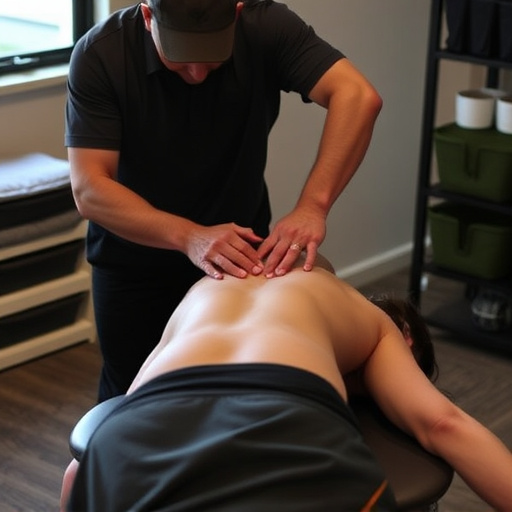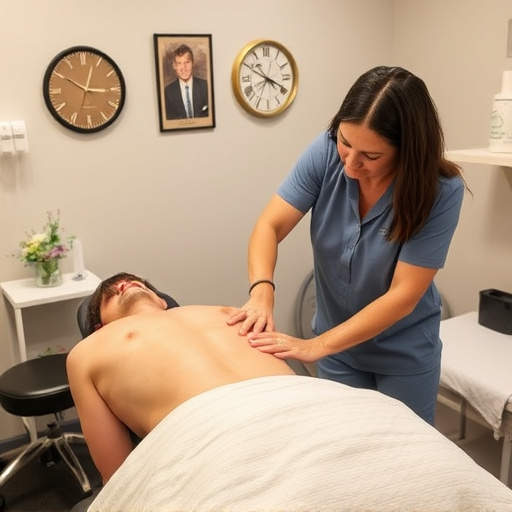Shockwave therapy for pain relief is a non-invasive treatment using sound waves to stimulate healing in damaged soft tissues. Preparation includes informing healthcare providers about medications and avoiding strenuous exercise before treatment. During the 15-30 minute session, low-energy sound waves are delivered through a gel-coated device. Most patients experience minimal discomfort and can resume normal activities afterward. Results may vary but can include improved mobility or reduced pain within days to weeks. Complementary treatments like physical therapy enhance benefits for optimal neck pain management. Adhering to healthcare provider instructions is crucial for best outcomes.
“Unwind the power of shockwave therapy—a revolutionary non-invasive treatment transforming pain management. This comprehensive guide equips you with essential knowledge to navigate your journey towards relief. From comprehending the science behind shockwave therapy’s pain reduction capabilities to mastering prep techniques and anticipating outcomes, we demystify each step. Whether you’re a patient seeking solace or a healthcare professional exploring advanced therapies, this article offers invaluable insights into effectively preparing for and harnessing the benefits of shockwave therapy for pain.”
- Understanding Shockwave Therapy for Pain Relief
- Preparation Tips Before Your Treatment Session
- What to Expect During and After Shockwave Therapy
Understanding Shockwave Therapy for Pain Relief

Shockwave therapy for pain relief is a non-invasive procedure that uses high-energy sound waves to stimulate healing in damaged tissues. This innovative treatment has gained popularity as an alternative to traditional chiropractic care and surgical interventions for musculoskeletal injuries. By targeting specific areas affected by chronic pain, shockwave therapy can provide significant relief for those struggling with conditions like tendinitis, muscle spasms, and even auto accident recovery-related discomfort.
Unlike some other therapies, shockwave treatment offers a quick and virtually painless experience. During the session, a specialized device emits acoustic waves that penetrate deep into the body, reaching areas of soft tissue damage. This process promotes the natural healing response of the body, encouraging the growth of new blood vessels and stimulating the regeneration of healthy tissue. Whether you’re considering shockwave therapy for chronic back pain, sports-related injuries, or recovery after an accident, understanding this advanced treatment option can empower you to make informed decisions regarding your musculoskeletal health.
Preparation Tips Before Your Treatment Session

Before your shockwave therapy for pain treatment, there are several preparation tips to ensure optimal results and comfort. First, inform your healthcare provider about any medications or supplements you’re taking, as they may need to adjust dosages or timing ahead of your session. It’s also crucial to avoid strenuous exercises or activities 24-48 hours prior to treatment, as these can increase blood flow and potentially interfere with the procedure’s effectiveness.
Additionally, dress in comfortable clothing that allows easy access to the treatment area. Plan for a relaxed state before and after the session, as shockwave therapy can cause temporary discomfort or mild pain. Consider bringing music or audiobooks to help you unwind. Remember, your healthcare provider will guide you through pre-treatment instructions specific to your condition, so follow their advice carefully. This includes any restrictions on eating or drinking before the appointment, which may be recommended for optimal absorption of the treatment’s benefits, especially for back pain relief or car accident injury care.
What to Expect During and After Shockwave Therapy

During shockwave therapy for pain, patients typically experience a series of low-energy sound waves being directed at the affected area. This non-invasive procedure is usually comfortable, with many reporting only a slight tingling or tapping sensation. The therapist will apply a gel to the skin and use a hand-held device to deliver the shockwaves, which can be adjusted for intensity based on individual needs. Most sessions last between 15 and 30 minutes, and while there may be some temporary mild discomfort afterward, it often subsides quickly.
Afterward, patients can usually resume their regular activities with minimal restrictions. Some individuals might notice improved mobility or reduced pain within a few days to weeks, but results can vary. Physical therapy or additional treatments, such as sports injury rehabilitation, might complement shockwave therapy for optimal neck pain treatment. It’s essential to follow the healthcare provider’s instructions and attend scheduled sessions to ensure the best possible outcomes from this innovative shockwave therapy for pain management.
Shockwave therapy for pain relief offers a non-invasive approach to managing chronic conditions. By preparing thoroughly before your treatment session, understanding what to expect during and after the procedure, you can ensure optimal results. Remember that each person’s experience is unique, so follow your healthcare provider’s guidance closely. With proper preparation and a knowledgeable care team, shockwave therapy could be a game-changer in your journey towards lasting pain relief.














